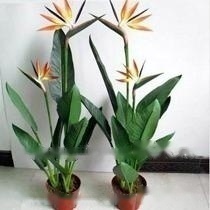
Chinese name: Strelitzia
Latin name: Strelitzia reginae Aiton
Nickname: Bird of Paradise, Bird of Paradise
Distribution Region: Southern Africa, USA, Germany, Italy, Netherlands, Philippines, China
Name and Year: Aiton l., 1970
1. Morphology of Strelitzia
> Strelitzia is a perennial herb without stem veins. Its leaves are oblong-lanceolate, ranging from 25 cm to 45 cm in length and about 10 cm in width. The top is relatively sharp and the root is round. Shaped or wedge-shaped, the lower edge is wavy, and the petiole is long and thin. The flowers are usually several on the common pedicel, the length of the pedicel and the petiole are not much different, and there are spathes below. Spathes are boat-shaped, 20 cm in length, green, with purplish red margins, lanceolate sepals, 7.5 to 10 cm in length, orange-yellow, arrow-shaped petals, and ear-shaped at the base The lobes, close to the length of the sepals, are dark blue. Stamens are the same length as petals. The anthers are narrowly linear and the style is more prominent.
2. Habits of Strelitzia
Strelitzia is native to southern Africa. Parks and flower beds are cultivated in large cities in southern China, and in greenhouses in the north. It is a subtropical long-day plant. It likes a warm, humid, sunny environment, fears severe cold, avoids extreme heat, avoids drought, and avoids waterlogging. Requires well-drained loose, fertile, sandy loam with pH 6-7. The optimum temperature during the growth period is 20-28°C. Strelitzia mainly includes 5 species, namely White-flowered Bird of Paradise, Leafless Strelitzia, Kew Gardens Strelitzia, Cordeta Strelitzia and Golden Strelitzia. Golden Strelitzia is a precious variety newly discovered in 1989, with a plant height of 1.8 meters, large flowers, and yellow calyx and petals.
3. Cultivation of Strelitzia
Cultivation of Strelitzia can be done by seed sowing, and the seeds with full grain, smooth seed coat, fresh, no damage, and no pests and diseases can be selected. . Soak the seeds in warm water at 30-40°C for 4-5 days, and then sterilize them with 5% 1000-fold solution of Sinjieer for 5 minutes. Sowing time May-July. Use on-demand, cover soil 1-1.5 cm, and cover with plastic film after watering to keep warm and moisturizing. The optimum temperature for germination is 25-30°C, and it can germinate 15-20 days after sowing and unearthed one after another. Increase light after emergence. After the true leaves grow, the main root begins to grow downward, which is the best time for transplanting. When transplanting seedlings, transplant with soil to prevent root damage. After transplanting, the seedlings should not be exposed to strong sunlight and need to be shaded. When 2 true leaves appear, start to fertilize lightly. When the seedlings are about 15 cm high, they are planted in pots. The optimum temperature for the growth of seedlings is 15-25 ℃, and the room temperature in winter is kept above 8 ℃. Seedlings are cultivated for 4-5 years and can flower normally when they have 9-10 leaves.
Guess you like it
Daisy | Chrysanthemum | Pear Flower | Wisteria | Calla Lily | Rose | Cymbidium | Rosemary | | white palm | kapok |
apricot flower | bark lotus | oleander | rose flower | mimosa | |
Saffron | Forget Me Not | Sunflower | Lily of the Valley | Gardenia | Poppy | Poppy | | Chunlan | Jasmine | Osmanthus | Paeonia | Campanulaceae | Datura | Violet | Anthurium | Camellia | Narcissus | Cyclamen |
![[Dog Training 5] The training method of pet dog dining etiquette](/static/img/12192/12192_1.jpg)




